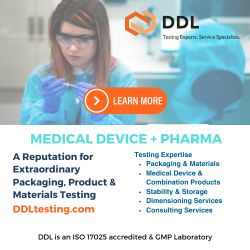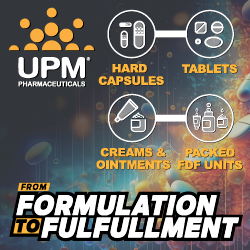Bioavailability & Solubility
Evonik Launches New Technology to Improve Solubility of Oral Small Molecules
Evonik recently announced it now offers EUDRATEC SoluFlow, a new microparticle technology to enhance solubility of active pharmaceutical ingredients in oral drug products…..
SPECIAL FEATURE - Solubility & Bioavailability: Utilizing Enabling Technologies
Contributor Cindy H. Dubin interviews several leading companies on how they are using innovative technologies, such as lipid nanoparticles to achieve a high drug loading, combining anti-solvent continuous crystallization with micro-mixing technology to control crystallization and reduce crystal size, and how a robotic capsule can improve bioavailability in the range of 47% to 78%.
FORMULATION DEVELOPMENT - Impact of Excipients & Manufacturing Process on Solubility-Enhanced Ritonavir Tablet Size & Weight Reduction
Gayatri Khanvilkar, MPharm, Ajit Bhagat, and Tejas Gunjikar, PhD, investigate bulking agents and disintegrants to develop efficacious Rotonavir tablets with improved in vitro release.
Catalent & TFF Pharmaceuticals Announce New Inhalation Dry Powder Development & Manufacturing Agreement
Catalent and TFF Pharmaceuticals, Inc. recently announced their collaboration agreement focused on the generation, testing, and manufacture of dry powder formulations for a range of…
TFF Pharmaceuticals Announces Inhaled Niclosamide Significantly Inhibits Viral Replication of the Omicron Variant of SARS-CoV-2
TFF Pharmaceuticals, Inc. recently announced that results from its recently completed in vitro neutralization and viral replication assays indicate that the company’s inhaled niclosamide product candidate completely….
HiberCell Initiates its Phase 1a/b Clinical Trial in Patients With Advanced Solid Tumors
HiberCell has recently initiated a Phase 1a/b clinical trial of HC-7366, a first-in-class selective, orally bioavailable modulator of General Control Nonderepressible 2 (GNC2) for the…
Hovione & Zerion Pharma Announce Strategic Partnership
Hovione recently announced a strategic partnership with Zerion Pharma to market and commercialize Dispersome, Zerion´s proprietary solubility enhancement….
Enteris BioPharma Highlights Progress in Oral Feasibility Program
Enteris BioPharma, Inc. recently provided an update on its oral feasibility programs involving the company’s Peptelligence and ProPerma oral peptide and small….
Valneva & Pfizer Report Further Positive Phase 2 Data for Lyme Disease Vaccine Candidate
Valneva SE and Pfizer Inc. recently reported further positive Phase 2 data for their Lyme disease vaccine candidate, VLA15. Based on these new results….
TFF Pharmaceuticals Completes Enrollment in Phase 1 Study Evaluating Inhaled Formulation of Niclosamide to Treat COVID-19
TFF Pharmaceuticals, Inc. recently announced it has completed enrollment of 40 healthy subjects in its Phase 1 clinical trial (CT.gov identifier NCT05168644) of a dry…
Catalent Completes $10-Million Expansion of High Potency Micronization Capabilities at US & UK Facilities
Catalent recently announced it has completed a $10-million expansion in state-of-the-art large-scale isolator units at its Malvern, PA, and Dartford, UK, facilities, to provide advanced…
BetterLife Obtains Positive In Vivo Oral Bioavailability, Food Effect & Pharmacokinetics Data for BETR-001
BetterLife Pharma Inc. recently announced it has obtained positive results from an in vivo oral bioavailability and food-effect pharmacokinetic (PK) study on BETR-001 in beagle…
FORMULATION FORUM - Formulation & Process of Lipid Nanoparticles for Delivery of Small Molecules & Biologicals
Jim Huang, PhD, explains how recently, lipid nanoparticles have emerged as a drug delivery system for biologicals, especially for the COVID-19 mRNA vaccines in which LNPs play a vital role in transporting mRNA into the target cells.
Starton Therapeutics Receives Clinical Trial Authorization in Europe to Initiate Phase 1 Clinical Trial of STAR-LLD Continuous Delivery Lenalidomide
Starton Therapeutics Inc. recently announced it has received a Clinical Trial Authorization (CTA) in the Netherlands to initiate a Phase 1 study evaluating STAR-LLD bioavailability in….
Adare Pharma Solutions Announces Appointment of Tom Sellig as Chief Executive Officer
Adare Pharma Solutions recently announced the appointment of Tom Sellig as Chief Executive Officer (CEO). Sellig, a 30-year veteran of the pharmaceutical and life sciences industries, will lead the….
TFF Pharmaceuticals Announces Final Data From Phase 1b Study of Inhaled Voriconazole Powder in Asthma Patients
TFF Pharmaceuticals, Inc. recently announced the full readout of safety and pharmacokinetic (PK) data from its Phase 1b study (NCT #04576325) of Inhaled Voriconazole Powder (TFF VORI) in asthma patients….
SWK Holdings’ Subsidiary, Enteris BioPharma, Receives $5-Million Milestone Payment From Cara Therapeutics
SWK Holdings Corporation recently announced its wholly owned subsidiary, Enteris BioPharma, received a $5- million milestone payment from Cara Therapeutics related to the license agreement for Peptelligence….
Ventyx Biosciences Announces First Patient Dosed in Phase 2 Clinical Trial of VTX002 for the Treatment of Moderate-to-Severe Ulcerative Colitis
Ventyx Biosciences, Inc. recently announced the first patient has been dosed in a Phase 2 randomized, placebo-controlled trial of VTX002 for the treatment of moderate-to-severe ulcerative colitis (UC)…..
Adare Pharma Solutions Acquires Frontida BioPharm to Expand Leading CDMO Offerings
Adare Pharma Solutions recently announced the acquisition of Frontida BioPharm, a vertically integrated CDMO focused on oral formulations. The acquisition reinforces….
2022 COMPANY PROFILES & CAPABILITIES
For each participating company, this section presents a detailed summary highlighting their core technologies, capabilities, technologies, and services.
Bioavailability and Solubility Challenges
Given that a large number of drugs fail to reach the market due to poor solubility and bioavailability, the industry is seeking various methods to mitigate this challenge while many choose to re-formulate existing product candidates. Either way, the demand for novel bioavailability and solubility enhancement methods has grown significantly. To cater to this increasing demand, many contract manufacturers and technology developers have emerged.
What is Solubility?
Solubility is the ability for a drug to be dissolved in an aqueous medium. Drug solubility is defined as the maximum concentration of a substance that can be completely dissolved in a given solvent at a certain temperature and pressure level.
Solubility of drugs is measured by the amount of solvent needed to dissolve one gram of the drug at a specific temperature. For example, a drug that is very soluble needs less than one part solvent to dissolve one gram of the drug. How soluble a drug is varies widely—a drug that is considered soluble needs 10-30 parts, one that is slightly soluble needs 100-1,000 parts and one that is practically insoluble or insoluble needs more than 10,000 parts. How soluble a drug is depends on the solvent, as well as temperature and pressure.
Since 1975, approximately 60 marketed drugs have leveraged solubilization technologies to enhance oral bioavailability. In the preceding 36 years, from the time the FDA required submission of an NDA in 1938, solubilization technology was virtually unused on a regular basis. Apparently, the disease areas focus, drug discovery methodologies, and the lack of mature solubilization platforms restricted the use prior to the 1970s.
In comparison, the past nearly 4 decades have shown robust growth in the reliance on solubilization platforms, accounting on average for around 9% of all NMEs approved from 1975 through 2022, and more than 10% in the past decade. Some years stand out to validate the need and use of solubilization platforms. For example, in 2005, 20% of NMEs approved used technologies including solid dispersion, lipid, and nanocrystal platforms. The data for the most recent 4-year period (2010-2013) seems to represent a slight decline in growth, but it is still early in the decade, and the data set is relatively small. Based on the trends throughout the past 4 decades and the changing chemical space in drug development, we expect the decade will show additional and significant current growth in use of solubilization technologies once we have visibility into the full 10-year period.
Bioavailability & Solubility Impediments
The biggest impediment in addressing bioavailability issues likely lies with a lack of deep familiarity with enabling technologies. Improving drug bioavailability begins with a thorough evaluation of the API’s physical and chemical properties in relation to solubilization in the dose, but more importantly its dissolution in vivo at the site of absorption.
These technologies, such as nanoparticles, cocrystals, computer-aided prodrug design, and electrospinning, represent innovations aimed at enhancing the solubility of a candidate molecule, particularly in the gastrointestinal tract. Technologies such as electrospinning, deep eutectic solvents, and ionic liquids are upcoming formulation approaches to enhance drug solubility, and as the science matures, and the relative strengths and weaknesses are better understood, we expect to see further application of these innovative approaches. They have shown to be successful for some compounds, and have a place alongside other bioavailability enhancement technologies, where each strategy has its benefits and corresponding liabilities. For them to be successful and widely adopted however, they will also have to provide a compelling benefit compared with other well-understood, and commercially precedented technologies, such as amorphous solid dispersions and lipid-based formulations.
Extreme compounds require either significant amounts of stabilizers to maintain the amorphous state or they are not amenable to common manufacturing technologies with reasonable cost of goods due to their low solubility in organic solvents. These include amorphous solid dispersions using polymethacrylate, cellulose, or povidone-based polymeric carriers, she says. In addition, thermostability of new molecular entities becomes an issue as most new molecules have melting points well above 400°F. Alternative production methods for amorphous solid dispersions can address these issues.





















